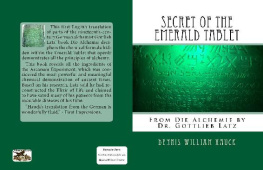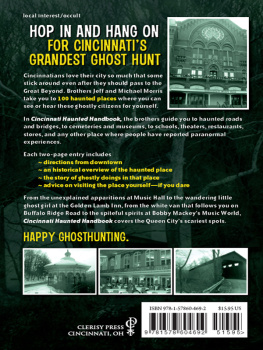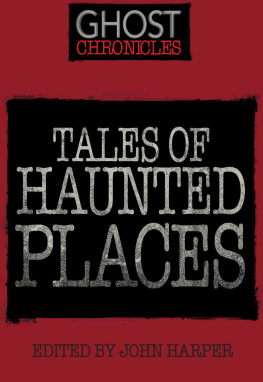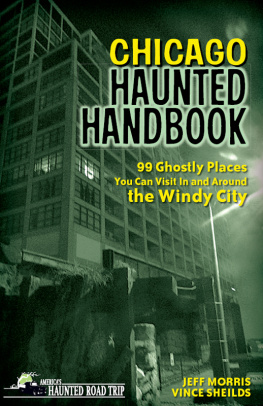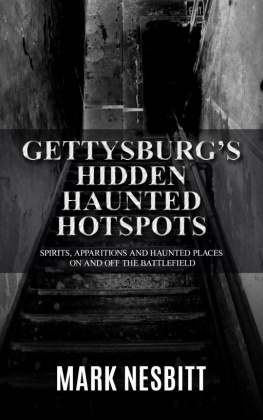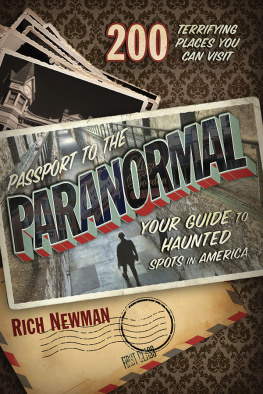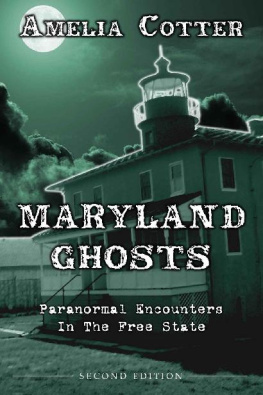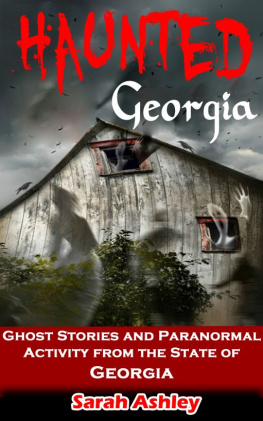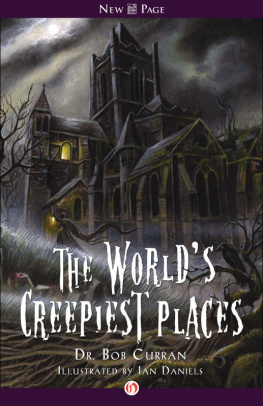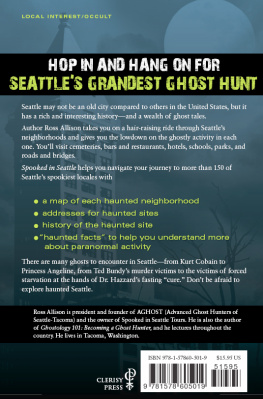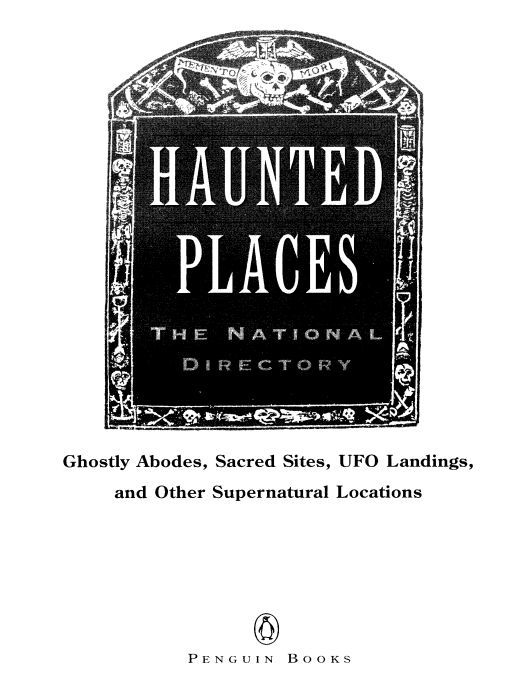Table of Contents
PENGUIN BOOKS
HAUNTED PLACES: THE NATIONAL DIRECTORY
Dennis William Hauck is an internationally known authority on paranormal phenomena. He is a member of the American Society for Psychical Research, California Coordinator for the Ghost Research Society, and Science Advisor to the Mutual UFO Network. The author of The International Directory of Haunted Places and The Emerald Tablet: Alchemy for Personal Transformation, he has served as contributing editor for a dozen periodicals and has consulted on several documentary films.
INTRODUCTION
This updated and revised edition of Haunted Places:
The National Directory offers the most authoritative and documented study of supernatural phenomena in the United States. This directory has become an essential sourcebook for researchers, librarians, and journalists throughout the country. The general public has embraced it as a handy travel guide and entertaining collection of stories of true hauntings.
This edition of Haunted Places features updated investigations, expanded address information, bibliographic references to each case, an exhaustive index, and for the first time, Internet sources for further information. Every effort will be made to post the most recent information about these locations at the authors Web site (www.Haunted-Places.com). If you find any corrections or new information about these or other unlisted sites, please email info@haunted-places.com or write the author (Dennis William Hauck, P.O. Box 22201, Sacramento, CA 95822).
Over the last decade, the
Haunted Places directories have spawned serious paranormal research in all fifty states, as well as inaugurating what has been dubbed the haunted travel industry. The fact that this book has become so popular with travelers necessitates repeating the basic precautions stated in earlier editions. Please keep these points in mind when visiting any of the locations described in this book:
Locations that welcome visitors are noted in the text. Secure the permission of owners or tenants of private residences before attempting to visit their property. Never trespass on private property, whether signs are posted or not. Please do not bother people unnecessarily and leave those alone who do not wish to be disturbed.
Always confirm and update directions locally. Every effort has been made to ensure the accuracy of the information presented in this directory; however, the author assumes no responsibility for errors, misprints, or changes. Check business hours and locations of public places such as museums, libraries, and historical sites before visiting them.
Some areas listed in this directory are in hazardous or isolated locations. Most desert locations should be avoided in the summer months. Some trails are intended for experienced hikers only. Deserted mines and caves are full of hidden dangers. A few city locations are in high crime areas. Be careful and always check locally before visiting any of the sites.
Native Americans are understandably protective of their sacred sites located on public lands. Never desecrate holy ground by taking unauthorized souvenirs or damaging property. Remember that a disrespectful attitude at a site sacred to anyone is an act of vandalism.
I wish to thank my associate researcher Matt Muller for his tireless work in listing, updating, and confirming the information provided here. Bruce Schaffenberger, the editor for the first printing of this book, also provided invaluable assistance in researching the entries. I would also like to extend my heartfelt thanks to the following independent investigators: Richard Foster, Troy Taylor, Richard. Senate, Dale Kaczmarek, L.J. Jones, Antonio Garcez, Lisa Farwell, Robert and Anne Wlodarski, Nancy Roberts, Mark Marimen, Bruce Carson, John Lamb, Judy Farncombe, Ron Beach, Heath Torstveit, Lee Holloway, Bernyce Barlow, George Eberhart, Gordon Ting, and William Uchaman.
ALABAMA
AUBURN
FIRST PRESBYTERIAN CHURCH The oldest public building in Auburn is haunted by the ghost of a Confederate soldier. Built in 1851 by a Presbyterian congregation, this chapel was used as a hospital during the Civil War. In 1864, a British volunteer fighting for the South was struck in the leg by cannon shrapnel, and by the time he received aid his leg had already turned gangrenous. He bled to death during an operation to remove the leg. The Englishman, Sydney Grimlett, was buried in a graveyard not far from the chapel. Everything was quiet until a theater group, the Auburn Players, took over the old chapel in the 1960s. Some say the emotional energy expended on the premises brought back Grimletts ghost. In any case, his restless phantom was seen by several members of the company who then used a Ouija board to discover his identity. Sydney made his presence known by moving props, whistling in the attic, tapping his one foot nervously, and producing startling, floating lights.
(Auburn is fifty miles northeast of Montgomery on I- 85. Grimletts grave is in the Pine Hill Cemetery. The building is once again a place of worship. It is on the corner of S. College and E. Thach streets at 143 E. Thach Ave., Auburn, AL 36830. Phone: 334-887-5571.)
BLADON SPRINGS
BLADON SPRINGS CEMETERY The ghost of Captain Norman Staples has been reported hovering over the graves of his four children: James Alfred, Berth Jaddetta, Mable Claire, and an unnamed baby. His ghost is said to have fled his burning stern-wheeler (see James T. Staples Riverboat, below) and taken refuge in the cemetery here. Stapless apparition seems to be protecting the grave although the captain is sometimes seen with his hands pressed against his head, as if he is suffering from great anguish or regret.
(Bladon Springs is in Choctaw County in southwestern Alabama. Take County Road 6 south from I-84. The cemetery is located on County Road 6. Follow Highway 84 east from the town of Bladon Springs for five miles. About a half mile after the bridge, turn right onto County Road 6 and follow it for three miles.)
James T. STAPLESRIVERBOAT Some believe that this proud riverboat was destroyed by the ghost of its captain. The stern-wheelers maiden voyage was in 1908. The most elegant vessel on Alabamas rivers, it was named after the father of the ships designer and first captain. His son Norman, captain and owner of the ship, had a hard time making ends meet because of unfair practices by a large steamboat company that wanted to operate all the boats on the river. Finally, in December 1912, creditors seized his beloved ship and turned it over to his competition. On January 2, 1913,
Captain Staples held a shotgun against his chest and pulled the trigger. Three days after he was buried, crew members began seeing the shadowy figure of their dead captain in the hold of the ship. The entire engine room crew quit and had to be replaced with workers who had never heard of the ghost. Next, all the rats that lived on the ship scurried ashore, a frightening premonition of things to come. Stapless ghost was seen roaming around the boilers belowdecks. Finally, on January 13, 1913, the ship docked at Powes Landing to take on wood. At the exact hour that Captain Staples took his own life, the boiler on the





